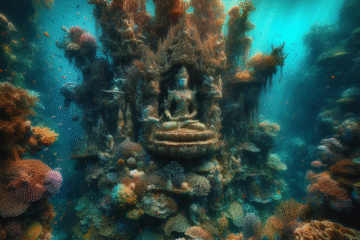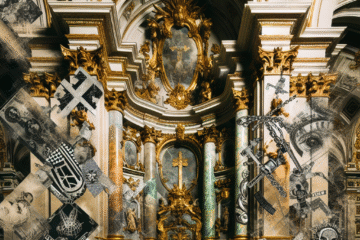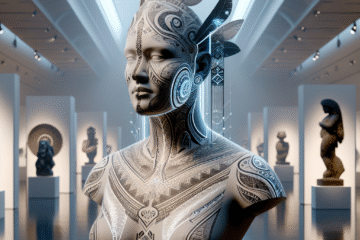I. Introduction
Art has the ability to evoke emotions in its viewers, and one of the most powerful tools that artists use to do this is color. The way colors are used in art can create a wide range of emotional responses in the viewer, from joy and excitement to fear and sadness. Understanding the emotional impact of color in art is important for both artists and viewers, as it can help to create a deeper connection to the work and enhance our understanding of its message.
The emotional impact of color has been recognized by many famous artists throughout history. Vincent van Gogh, for example, is known for his bold use of color to convey emotion in his paintings, such as the intense blues and yellows in “Starry Night”. Another famous artist, Mark Rothko, used color to create a sense of spirituality and contemplation in his large abstract paintings. His use of vibrant colors and blurred edges in works such as “Orange and Yellow” and “No. 61 (Rust and Blue)” creates a sense of depth and emotion that is difficult to describe.
The emotional power of color is not limited to famous artists, however. Many contemporary artists continue to explore the emotional impact of color in their work. For example, Yayoi Kusama’s use of bright colors and polka dots creates a sense of joy and playfulness in her installations, while Anish Kapoor’s use of deep, rich colors in his sculptures creates a sense of weight and power.
Understanding the emotional impact of color in art is important not only for appreciating the work of famous artists but also for creating new works of art. Artists can use color to create specific emotional responses in their viewers, whether it’s a feeling of excitement or a sense of calm. By studying the ways that colors can affect emotions, artists can create more powerful and effective works of art.
In the following sections, we will explore the psychology of color, color in art history, contemporary uses of color in art, the intersection of color and culture, and the importance of exploring the emotional impact of color in art. By the end of this article, readers will have a better understanding of the ways that color can affect our emotions and how artists use this powerful tool to create works of art that are both beautiful and emotionally resonant.
II. The Psychology of Color
Color is a powerful tool that can evoke emotions, create moods, and convey meaning in art. The psychology of color is the study of how color affects human behavior and emotions. Understanding the psychological effects of different colors is essential for artists who want to create works that connect with viewers on an emotional level.
Different colors have different psychological effects. Red, for example, is often associated with passion, love, and danger. It is a bold and energetic color that can evoke feelings of excitement, but it can also create a sense of danger or warning. Blue, on the other hand, is often associated with calmness, trust, and stability. It is a soothing and peaceful color that can create a sense of relaxation and tranquility. Yellow is associated with happiness, optimism, and energy. It is a bright and cheerful color that can create a sense of positivity and playfulness.
Other colors also have unique psychological effects. Green is often associated with growth, balance, and harmony. It can create a sense of peace and healing. Purple is associated with luxury, power, and creativity. It can create a sense of sophistication and elegance. Orange is associated with warmth, enthusiasm, and creativity. It can create a sense of excitement and energy.
The psychological effects of color are not just limited to individual colors. The way colors are used together can also create specific emotions and moods. Complementary colors, such as red and green or blue and orange, can create a sense of energy and excitement. Analogous colors, such as blue and green or red and orange, can create a sense of harmony and calmness.
Color can also affect our moods and emotions in more subtle ways. Bright colors tend to create a sense of excitement and energy, while muted colors create a sense of calmness and relaxation. Warm colors, such as red, orange, and yellow, tend to create a sense of warmth and comfort, while cool colors, such as blue and green, tend to create a sense of coolness and relaxation.
Understanding the psychological effects of color is important for artists who want to create works that connect with viewers on an emotional level. By using color strategically, artists can create specific emotions and moods that enhance the overall message of their work. Viewers can also benefit from understanding the psychological effects of color, as it can help them better appreciate the emotional impact of a work of art.
In conclusion, the psychology of color is an essential tool for artists who want to create works that connect with viewers on an emotional level. By understanding the psychological effects of different colors, artists can create specific emotions and moods that enhance the overall message of their work. Viewers can also benefit from understanding the psychological effects of color, as it can help them better appreciate the emotional impact of a work of art.
III. Color in Art History
Color has played an important role in art throughout history. Different art movements have used color in unique and innovative ways to create a wide range of emotional responses in the viewer. In this section, we will explore some of the ways that color has been used in art history to convey different emotions and themes.
One of the earliest examples of the use of color in art is the Byzantine art of the 6th and 7th centuries. In Byzantine art, colors were used to convey different levels of spiritual importance. Gold, for example, was used to represent the divine, while blue represented the heavens. The use of color in this way helped to create a sense of sacredness in religious art.
During the Renaissance, artists began to use color more realistically. This was seen in the works of artists such as Leonardo da Vinci and Michelangelo, who used color to create a sense of depth and realism in their paintings. This realistic use of color helped to create a sense of naturalism in art.
In the Baroque period, artists began to use color to create a sense of drama and emotion. This can be seen in the works of artists such as Caravaggio and Rembrandt, who used strong contrasts of light and dark to create a sense of theatricality in their paintings.
In the 19th century, the Impressionist movement revolutionized the use of color in art. Artists such as Claude Monet and Pierre-Auguste Renoir used color to capture the effects of light and atmosphere in their paintings. This created a sense of movement and spontaneity in their work. The use of color in Impressionism helped to create a sense of vibrancy and energy in art.
The Fauvist movement of the early 20th century took the use of color to a new level. Artists such as Henri Matisse and Andre Derain used bright, bold colors to create a sense of energy and spontaneity in their work. This use of color was seen as a rebellion against the traditional use of color in art and helped to create a sense of modernity in art.
Color has also been used to convey specific emotions and themes in art. For example, in the Romantic period, artists used color to create a sense of emotion and sentimentality. The use of bright, vibrant colors helped to create a sense of passion and intensity in art. In contrast, the use of muted, subdued colors in the Realist movement helped to create a sense of seriousness and sobriety in art.
In conclusion, the use of color in art has evolved over time and has been used to convey different emotions and themes. From the sacred use of color in Byzantine art to the bold, bright colors of the Fauvists, color has played a vital role in creating the emotional impact of art throughout history. Understanding the ways that color has been used in art can help viewers appreciate the emotional depth of a work and the message that the artist is trying to convey.
IV. Contemporary Uses of Color in Art
Contemporary artists continue to push the boundaries of art through the use of color. The use of color in contemporary art has become increasingly experimental and innovative, with many artists exploring the emotional impact of color in new and exciting ways. In this section, we will explore how contemporary artists are using color in their work and highlight some specific examples of artists who are using color to create powerful emotional effects.
One way that contemporary artists are using color is by creating installations that immerse the viewer in a world of color. One such artist is James Turrell, who creates installations that use light and color to create an immersive experience for the viewer. Turrell’s installations, such as “Apani,” create a sense of transcendence through the use of color and light. The installations create a sense of space that is both physical and emotional, allowing the viewer to experience color in a new and powerful way.
Another contemporary artist who is using color in innovative ways is Olafur Eliasson. Eliasson’s work often explores the relationship between light and color, using both to create immersive installations that create a sense of awe and wonder in the viewer. His installation “Your Rainbow Panorama” is a circular walkway that is covered in colored glass, creating a sense of rainbow-colored wonder that envelops the viewer.
Contemporary artists are also using color to create powerful emotional effects. One such artist is Anish Kapoor, who creates sculptures that use color to create a sense of weight and power. Kapoor’s sculpture “Cloud Gate” is a massive stainless steel sculpture that is covered in a reflective material that creates a sense of infinite depth. The use of color in the sculpture creates a sense of power and awe that is both physical and emotional.
Another artist who uses color to create emotional effects is Kerry James Marshall. Marshall’s paintings often use bold, bright colors to create a sense of joy and celebration in his work. His use of color is often a celebration of black culture and history, creating a sense of pride and empowerment in his viewers.
Finally, contemporary artists are also using color to create political and social messages. Ai Weiwei, for example, uses bright, bold colors in his installations to create a sense of activism and protest. His installation “Sunflower Seeds” consists of thousands of porcelain sunflower seeds that are painted with a bright yellow glaze, creating a sense of political resistance and protest.
In conclusion, contemporary artists are using color in new and innovative ways to create powerful emotional effects in their work. From immersive installations to powerful sculptures, contemporary artists are exploring the emotional impact of color in exciting new ways. By using color to create powerful emotional effects, contemporary artists are creating works that challenge and inspire their viewers.
V. The Intersection of Color and Culture
Color is not only a tool for emotional expression in art, but it is also an important aspect of culture. Different cultures have different associations with colors, and these associations can be used in art to create powerful messages. In this section, we will explore how the intersection of color and culture is being used by artists to create impactful works of art.
Different cultures have different associations with certain colors. For example, in China, red is associated with good luck, happiness, and prosperity. It is a color that is often used in celebrations and ceremonies, and is considered a lucky color. In Western culture, however, black is often associated with mourning and sadness. It is a color that is often worn to funerals and is considered a solemn color.
These cultural associations with color can be used by artists to create powerful messages in their work. For example, the Chinese artist Ai Weiwei has used the color red in his installations to create a sense of political protest and resistance. In his installation “Remembering,” Ai Weiwei covered the pillars of the Kunsthaus Bregenz in red, creating a sense of warning and danger. The use of red in this installation was a commentary on the political situation in China and was a call for resistance and protest.
Similarly, the American artist Glenn Ligon has used the cultural association of black with sadness and mourning to create powerful works of art. In his painting “Untitled (I Am a Man),” Ligon used the phrase “I Am a Man,” which was used by black sanitation workers in Memphis in the 1960s to protest their working conditions. The words are painted in black against a white background, creating a powerful message about race and inequality in America.
Cultural associations with color can also be used to create works of art that celebrate different cultures. For example, the Indian artist Anish Kapoor has used the color red in his work to celebrate Indian culture. In his installation “Descension,” Kapoor created a circular pool of water that is colored red. The installation was a commentary on the ancient Indian practice of kundalini yoga and was a celebration of Indian culture and spirituality.
In conclusion, the intersection of color and culture is an important aspect of art that can be used to create powerful messages. Artists are using the cultural associations of color to create works of art that celebrate different cultures, protest against political situations, and create powerful messages about race and inequality. By using the cultural associations of color in their work, artists are creating works that are not only aesthetically beautiful but also emotionally impactful.
VI. Conclusion
In this article, we have explored the emotional impact of color in art. We have discussed the psychology of color, color in art history, contemporary uses of color in art, and the intersection of color and culture. Throughout these discussions, we have seen how color can create a wide range of emotional responses in the viewer and how artists use this powerful tool to create works of art that are both beautiful and emotionally resonant.
The psychology of color has shown us that different colors have different psychological effects. Red can create a sense of passion and danger, blue can create a sense of calmness and trust, and yellow can create a sense of happiness and optimism. By understanding the psychological effects of different colors, artists can create works that connect with viewers on an emotional level.
The use of color in art history has evolved over time, from the sacred use of color in Byzantine art to the bold, bright colors of the Fauvists. Different art movements have used color to convey different emotions and themes, creating a rich history of color in art.
Contemporary artists are using color in new and innovative ways to create powerful emotional effects in their work. They are creating immersive installations, powerful sculptures, and works that challenge and inspire their viewers. By using color to create powerful emotional effects, contemporary artists are creating works that are both aesthetically beautiful and emotionally impactful.
Finally, we have seen how the intersection of color and culture is being used by artists to create powerful messages in their work. Different cultures have different associations with colors, and these associations can be used to create works of art that celebrate different cultures, protest against political situations, and create powerful messages about race and inequality.
The emotional impact of color is so important in art because it is what connects the viewer to the work. By understanding how color can create specific emotional responses in the viewer, we can appreciate the emotional depth of a work of art and the message that the artist is trying to convey.
As readers, it is important to consider how color is affecting us emotionally when we view art. By paying attention to the emotional impact of color, we can better appreciate the work of art and the emotional connection that it creates with us as viewers.
In conclusion, the emotional impact of color is a powerful tool in art that connects the viewer to the work. By understanding the psychology of color, the history of color in art, the contemporary uses of color, and the intersection of color and culture, we can better appreciate the emotional depth of a work of art and the message that the artist is trying to convey.


